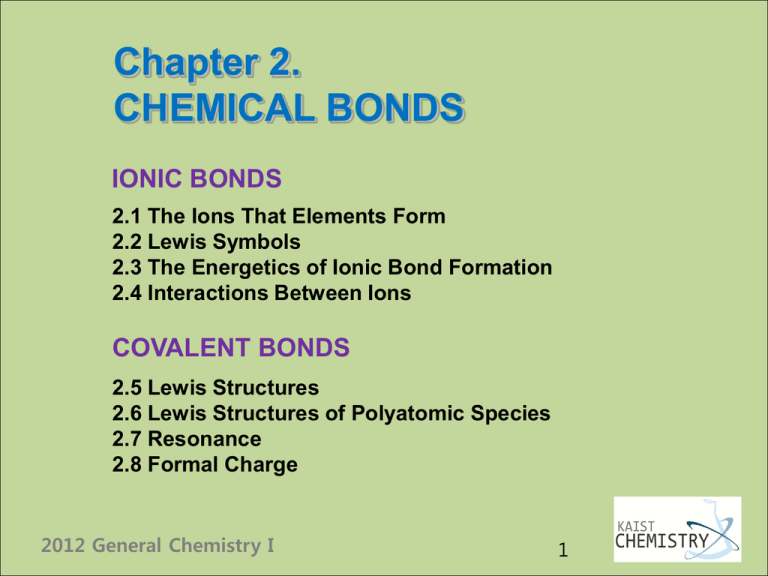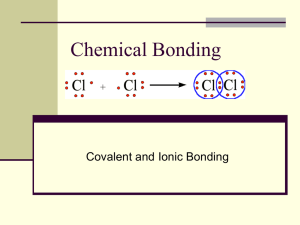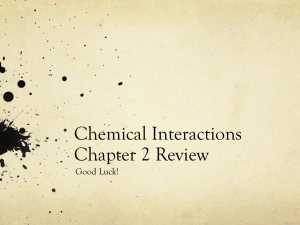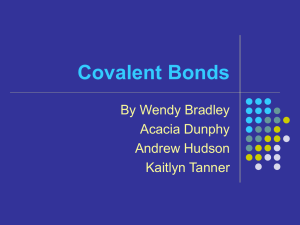2012 General Chemistry I
advertisement

Chapter 2.
CHEMICAL BONDS
IONIC BONDS
2.1 The Ions That Elements Form
2.2 Lewis Symbols
2.3 The Energetics of Ionic Bond Formation
2.4 Interactions Between Ions
COVALENT BONDS
2.5 Lewis Structures
2.6 Lewis Structures of Polyatomic Species
2.7 Resonance
2.8 Formal Charge
2012 General Chemistry I
1
Key Ideas and Definitions
Bond formation is accompanied by a lowering of energy: it is
a favorable process.
Formation of chemical bonds results in ionic lattices,
molecules,and metallic lattices.
It is fundamental to the production of compounds and so is
central to the science of chemistry.
Energy lowering is due to attractions between oppositely
charged ions (ionic bonding), or between nuclei and shared
electron pairs (covalent bonding).
Chemical bond is the link between atoms.
- ionic bond
i.e. Na+, Cl-
- covalent bond i.e. NH3
- metallic bond
i.e. Cu
2012 General Chemistry I
2
IONIC BONDS (Sections 2.1-2.4)
Ionic model: the description of bonding in terms
of ions
An ionic solid is an assembly of cations and anions
stacked together in a regular pattern, called a crystal
lattice.
2.1 The Ions That Elements Form
Cations are formed by removal of outermost electrons in
the order np, ns, (n-1)d.
Main-group metal atoms lose their valence s- and/or pelectrons and acquire the electron configuration of the
preceding noble gas atom.
2012 General Chemistry I
3
Anions: Add electrons until the next noble-gas configuration is reached
2012 General Chemistry I
4
Self-Tests 2.1B and 2.2B
2.1B Write the electron configurations of (a) the Manganese
(II) ion and (b) the lead (IV) ion.
Solution: (a) Mn is [Ar] 3d5 4s2, hence Mn2+ is [Ar] 3d5
(b) Pb is [Xe] 5d10 4f14 6s2 6p2, hence Pb4+ is [Xe] 5d10 4f14
2.2B Write the chemical formula and electron configuration of
the iodide ion.
Solution: I needs to gain only one electron to achieve Xe
electron structure, hence I- and [Xe] or [Kr] 4d10 4s2 4p6
2012 General Chemistry I
5
2.2 Lewis Symbols
Atoms and ions are conveniently represented by Lewis dot
symbols, showing the element symbol, the valence electrons
and charge, if any.
Valence electrons – depicted as dots; a pair of dots for paired electrons.
- Atoms
- Cations and anions
Here, we can use Lewis dot symbols to show electron transfer in
the formation of cations and anions.
2012 General Chemistry I
6
Gilbert N Lewis
2012 General Chemistry I
7
2.3 The Energetics of Ionic Bond Formation
The formation of a typical ionic compound, such as sodium
chloride can be broken down into three simple steps:
1. Ionization of gaseous metallic atom to give the cation.
2. Formation of gaseous non-metallic anion.
3. Condensation of the gaseous ions into a crystal lattice.
The energies involved in these processes illustrate the favorability
of ionic compound formation (see Fig. 2.4, next slide):
Na(g) → Na+(g) + e- (g)
494 kJ·mol-1
Cl(g) + e- (g) → Cl-(g)
-349 kJ·mol-1
Na+(g) + Cl- (g) → NaCl(s)
-787 kJ·mol-1
Na(g) + Cl(g) → NaCl(s)
-642 kJ·mol-1
2012 General Chemistry I
8
Energetics of ionic
compound formation.
The difference in energy
between the ions in the
lattice and separated
gaseous ions is called
the lattice energy.
2012 General Chemistry I
9
2.4 Interactions Between Ions
- In an ionic solid, each cation is attracted to all the anions to a greater
or lesser extent. This is a “global” characteristic of the entire crystal
Lattice energy: the difference in energy between the ions packed
together in a solid and the ions widely separated as a gas
- Strong electrostatic interactions in ionic solids
→ high melting points and brittleness
2012 General Chemistry I
10
- Coulomb
potential energy of the interactions of
two individual ions:
Here, e is the fundamental charge; z1 and z2 are the charge numbers of the
two ions; r12 is the distance between the centers of the ions; e0 is the
vacuum permittivity constant.
- Molar
potential energy of a three-dimensional crystal:
d = distance between centers of
neighboring ions (rcation + ranion)
NA is the Avogadro number
The factor A is the Madelung constant,
dependent on how the ions are arranged
about one another in the 3-dimensional
lattice.
2012 General Chemistry I
11
One-Dimensional Crystal Model
- In a one-dimensional crystal in which cations and anions alternate
along a line:
2012 General Chemistry I
12
This implies Ep is most favorable for small ions with large charges.
Also for a one dimensional model crystal, the Madelung constant A
is 2 ln2 = 1.386. This compares well with values of A for real ionic
crystals (Table 2.2).
For multi-charged ions (z1 and z2), z2 is replaced by the absolute
value of z1z2 (its value without the negative sign).
2012 General Chemistry I
13
Self-Test 2.3A
The ionic solids KCl and CaO crystallize to form
structures of the same type. In which compound
are the interactions between the ions stronger?
Solution: The ions in CaO are both smaller and
more highly charged, hence CaO has the stronger
interactions.
2012 General Chemistry I
14
Attraction, Repulsion and the Born-Mayer Equation
The previous discussion
does not take into account
cation-anion repulsion – the
real potential energy of an
ionic solid is a balance
between attractive and
repulsive interionic
interactions.
If a cation and anion are
brought together (see Fig.
2.7, opposite), potential
energy decreases to a
minimum value.
Further decrease in d, leads
to serious unfavorable
repulsive interaction.
2012 General Chemistry I
15
Born-Mayer equation
with d* = 34.5 pm
repulsive effect
This equation allows for repulsive interactions at
small values of d: EP,min increases (becomes less
favorable) when d approaches d* and is actually
positive when d* > d.
2012 General Chemistry I
16
COVALENT BONDS (Sections 2.5-2.8)
2.5 Lewis Structures
Some Definitions According to Lewis Theory
Covalent bond - a pair of electrons shared between two atoms
- Octet rule: in covalent bond formation, atoms go as far as possible
toward completing their octets by sharing electron pairs.
- Valence of an atom is the number of bonds it can form.
- A line (-) represents a shared pair of electrons.
- Lone pairs of electrons – electron pairs not involved in bonding.
- Lewis structure – atoms are indicated by chemical symbols,
covalent bonds by lines, and lone pairs by pairs of dots.
2012 General Chemistry I
17
Self-Test 2.4A
Write the Lewis structure for the “interhalogen”
compound chlorine monofluoride, ClF, and state
how many lone pairs each atom possesses in the
compound.
Solution
..
..
: F . + . Cl:
..
..
.. . ..
.. ..
: F . Cl: or : F Cl:
.. ..
.. ..
Three lone pairs on
both atoms
2012 General Chemistry I
18
2.6 Lewis Structures of Polyatomic Species
– A Lewis structure does not portray the 3D shape of a molecule
or ion, but simply displays which atoms are bonded together.
-
- bond order: the number of bonds that link a specific pair of atoms.
2012 General Chemistry I
19
Writing a Lewis Structure
1. Count the total number of valence electrons, from the group
numbers
E.g. CO2
4 + 2 x 6 = 16 (C in group IVA; O in group VIA)
NOTE: if an anion (-), add the value of the charge; if a cation (+),
subtract that value.
2. Calculate the total number of electrons that are needed if each
atom had its own noble gas shell of electrons (2 for H and 8 for
all others).
E.g. for CO2 there are 3 atoms (no H) and hence 24 noble gas shell
electrons.
3. Subtract the number in 1 from the number in 2: this gives the
number of shared (bonding) electrons present (and number of
bonds = 1/2 that number).
4. Add electron pairs to “complete the octets”, as necessary.
5. Represent each bond by a line.
2012 General Chemistry I
20
E.g. for CO2, the figure is 24 – 16 = 8 (4
bonds: two “double bonds”)
Hence the Lewis diagram is
.. : :
:O : C :
or
..
:O C
..
O:
..
O:
The above works well only for molecules that obey the octet
rule. For certain molecules (like BF3, radicals, and high valence
compounds like SF6), this rule is ignored.
2012 General Chemistry I
21
Writing a Lewis Structure: Rules of Thumb
- Terminal atom: bonded to only one other atom
- Central atom: bonded to at least two other atoms
– Usually, element with lowest I1 or lowest electronegativity
is central atom. E.g., in HCN, carbon has lowest I1 and is least
electronegative: hence it is the central atom.
– Usually, there is symmetrical arrangement around central atom.
E.g., in SO2, OSO is symmetrical, with S central and O terminal.
– Oxoacids have H atoms mostly bonded to O atoms. E.g., H2SO4
is actually (HO)2SO2, with two O atoms and two OH groups
bonded to S.
– For organic compounds, the atoms are arranged into groups,
as suggested by the standard molecular formula. E.g., CH3COOH
= one CH3 group and one COOH group.
2012 General Chemistry I
22
Examples
..
..
HO
..
: OH
P
..
..
O:
..
..OH
H3C
Phosphorous acid,
P(OH) 3
H
H
N
+
H
..
:O
..
..
O:
C
H
C
CH3
Acetone, (CH3)2CO
2..
O
.. :
H
H
+
N H
H
Ammonium carbonate, (NH4)2CO 3
2012 General Chemistry I
23
Self-Test 2.5A
Write a Lewis structure for the cyanate ion, NCO(sometime written CNO-).
Solution
..
:N
..
C
O:
_
..
or
2012 General Chemistry I
N
C
..
O:
..
_
Self-Test 2.6A
Write a Lewis structure for the urea molecule,
(NH2)2CO
Solution
H
..
H
H
O:
H
N
C
N
..
..
H
H
N
C
from skeleton
H
N
H
2012 General Chemistry I
25
O
2.7 Resonance
– Multiple Lewis structures: many compounds can be represented by
different Lewis structures in which the location of electrons (but not
nuclei) differ.
They are known as resonance structures, each making a contribution
to the real structure of the molecule (called a “resonance hybrid”).
– The resonance symbol is a double-headed arrow (↔),
indicating a blend of the contributing structures:
– Resonance implies delocalization: in which a shared electron pair is
distributed over several pairs of atoms and cannot be identified with
just one pair of atoms.
2012 General Chemistry I
26
Benzene, C6H6
- No reactions typical of compounds with double bonds
- All the carbon-carbon bonds with the same length
- Only one 1,2-dichlorobenzene exists.
2012 General Chemistry I
27
Self-Test 2.7B
Write Lewis structures contributing to the resonance
_
hybrid for the nitrite ion, NO2
Solution
_ ..
:O
..
..
N
..
..
O:
The resonance hybrid is
2012 General Chemistry I
:O
O
N
_
.. _
O:
..
..
N
O
28
Additional Self-Test
Write Lewis (resonance structures) for the ozone molecule (O3).
Comment on the predicted bond lengths.
Solution
..
.. ..
:O O O :
..
..
:O
..
O
..
:
O
..
(Without formal charges: see 2.8)
Suggests bonds are equal in length:
O
O
O
r(O=O) < r(O O) < r(O
Resonance hybrid
2012 General Chemistry I
29
O)
2.8 Formal Charge
Formal charge – the charge an atom would have if the bonding
were perfectly covalent in the sense that the atom had exactly a halfshare of the bonding electrons.
V = the number of valence electrons in the free atom
L = the number of electrons present on the bonded atom as lone pairs
B = the number of bonding electrons on the atom
- A Lewis structure in which the formal charges of the individual atoms
are closest to zero typically represents the lowest energy arrangement
of the atoms and electrons.
2012 General Chemistry I
30
– Formal charge exaggerates the covalent character of bonds by
assuming that the electrons are shared equally.
– Oxidation number (state) exaggerates the ionic character of bonds.
It represents the atoms as ions, and all the electrons in a bond
are assigned to the atom with the lower ionization energy.
formal charge
2012 General Chemistry I
oxidation state
31
Self-Test 2.8B
Suggest a likely structure for the oxygen difluoride
molecule. Write its Lewis structure and formal charges.
Solution
0
..
:F
..
0
..
O
..
0
..
F:
..
(not
0
..
:F
..
+1 -1
.. ..
F O: )
.. ..
:
2012 General Chemistry I
32
Chapter 2. CHEMICAL BONDS
EXCEPTIONS TO THE OCTET RULE
2.9 Radicals and Biradicals
2.10 Expanded Valence Shells
2.11 The Unusual Structures of Some Group 13/III Compounds
IONIC VERSUS COVALENT BONDS
2.12 Correcting the Covalent Model: Electronegativity
2.13 Correcting the Ionic Model: Polarizability
THE STRENGTH AND LENGTHS OF COVALENT BONDS
2.14 Bond Strength
2.15 Variation in Bond Strength
2.16 Bond Lengths
2012 General Chemistry I
33
2.9 Radicals and Biradicals
There are three types of molecules for which
the octet rule of Lewis has to be dropped:
1. Odd-electron molecules (radicals)
2. High valence molecules (hypervalent
compounds) (See 2.10)
3. Low valence molecules (especially of group IIA
and IIIA elements) (See 2.11)
2012 General Chemistry I
34
Radicals are species with at least one unpaired electron.
They are often highly reactive.
Examples
.
:N
..
O:
Biradicals: molecules with two unpaired electrons
2012 General Chemistry I
Self-Test 2.9A
Write a Lewis structure for the hydrogenperoxyl
radical, HOO. (etc).
Solution
H
:O
..
.
:
O
..
The unpaired electron is
best accommodated on
the singly bonded O
2012 General Chemistry I
36
2.10 Expanded Valence Shells
High valence compounds of elements in and beyond period 3
require Lewis structures that disobey the octet rule - more than
8 electrons are associated with the central atom in a Lewis structure.
These are often called hypervalent compounds.
Examples:
..
:O
..
HO
..
P
..
OH
..
: OH
..
Phosphoric acid
..
:Cl
..
..
: Cl
..
xx
S
..
:OH
..
Cl
.. :
..
:
Cl
..
Sulfur tetrachloride
2012 General Chemistry I
..
:O
S
..
O:
..
:I
..
: OH
..
Sulfuric acid
xxxx ..
:
I
..I
xx
Triiodide anion
37
_
– Variable covalence: the ability of certain elements to form different
numbers of covalent bonds. Prevalent in elements of the p block in
and beyond period 3.
PCl3(l) + Cl2(g)
Phosphorus trichloride
..
..
: Cl
..
P
..
Cl :
..
: Cl
.. :
Obeys octet
rule for P
2012 General Chemistry I
PCl5(s)
..
: Cl
..
..
: Cl
..
P
..
Cl :
..
..
Cl : Phosphorus pentachloride
..
: Cl
.. :
Disobeys octet
rule for P
38
Self-Test 2.10A
Write a Lewis structure for xenon tetrafluoride,
XeF4, and give the number of electrons in the
expanded valence shell.
Solution
..
:F:
..
xx ..
: F Xe F :
..
.. xx
12 electrons around Xe
:F:
..
2012 General Chemistry I
39
Self-Test 2.11A
Calculate the formal charge for the two Lewis
structures of the phosphate ion shown in (27).
Solution
.. -1
_
: O:
3
..-1 +1 .. -1
:O P O :
..
..
:O :
..
-1
..
_
:O 0
3
-1
..
0 .. -1
:O P O :
..
..
:O :
..
-1
Bigger contribitor to
resonance hybrid
2012 General Chemistry I
40
2.11 The Unusual Structures of Some Group
IIIA/13 Compounds
– Incomplete octet: many of the compounds of group IIIA
are characterized by fewer than eight valence electrons around
the central atom:
E.g. Compounds of B and Al
..
:F
..
..
:F :
B
..
F :
..
Boron trifluoride
2012 General Chemistry I
..
: Cl
..
..
:Cl :
Al
..
Cl :
..
Aluminum trichloride
(gaseous)
41
– Their chemistry is dominated by completing octets using a
coordinate covalent bond, in which both electrons come from a
terminal atom.
..
:Cl
..
Al
..
: Cl
..
..
..
Cl
Cl :
..
..
.. Al ..
Cl
Cl :
..
..
Aluminum chloride
(anhydrous solid)
BF3 + F
H
F
..
: :
+
N
F
_
B F
..
.. :
2012 General Chemistry I
H
..
: ..
NH3.BF3
BF4
..
:F
..
-
B
: F:
..
H
NH3 + BF3
-
..
:F :
42
_
..
F :
..
IONIC VERSUS COVALENT BONDS
(Sections 2.12-2.13)
2.12 Correcting the Covalent Model:
Electronegativity
– Many covalent compounds have polar covalent bonds (with partial
ionic character).
– Polar covalent bond: a bond in which ionic contributions to
resonance result in partial (d+ and d-) charges (the actual charges
on the atoms in a molecule). Bond electrons in the resonance hybrid
are shared unevenly.
H
..
Cl :
..
d+
H
.. _
+
H : Cl :
..
d
Cl
_ ..
(not H: : Cl + )
..
_
2012 General Chemistry I
43
– An electric dipole results when a partial positive charge is
next to an equal but opposite partial negative charge. It can
be represented in two ways:
- electric dipole moment (m): size of an electric dipole
Debye
For a Cl-H bond: m = ~1.1 D, indicating considerable ionic
character (~23%)
2012 General Chemistry I
44
Electronegativity
Electronegativity (c) was first defined by Linus Pauling
(1932) as the electron-pulling power of an atom when it is
part of a molecule.
Pauling’s electronegativity scale is based on the difference in bond
dissociation energies (in eV) between A-A, B-B, and A-B.
The electronegativity difference between two elements A and B is:
cA – cB = {D(A-B) – ½[D(A-A) + D(B-B)}1/2
In time, the electronegativity of fluorine was chosen as 4.0, and
electronegativities of other elements are determined relative to
this (maximum) value. See next slide for electronegativities of
main group elements (Fig. 2.12)
2012 General Chemistry I
45
Electronegativities of Main Group elements (Fig. 2.12)
c
increases
from left
to right
and
from
bottom to
top
2012 General Chemistry I
46
Linus Pauling
2012 General Chemistry I
47
Robert Mulliken devized an electronegativity scale based on
ionization energy and electron affinity:
- Mulliken scale: c = ½(I1 + Eea)
(average of the ionization
energy and electron affinity)
Is a bond, covalent, polar
covalent or ionic?
-Rough rules of thumb based on
electronegativity difference (Fig. 2.13):
ionic
polar covalent
covalent
Examples:
NaCl or KF : ionic
C-O
: polar covalent
Ca-O
: ionic
2012 General Chemistry I
48
Self-Test 2.12A
In which of the following compounds do the bonds have
greater ionic character: (a) P4O10 or (b) PCl3?
Solution
Difference in c for P and O = 1.2
Difference in c for P and Cl = 1.0
Hence the bonds in (a) have greater ionic
character.
2012 General Chemistry I
49
2.13 Correcting the Ionic Model: Polarizability
– All ionic bonds have some covalent character.
– Highly polarizable atoms and ions readily undergo a large
distortion of their electron cloud.
i.e. large anions and atoms such as I-, Br-, and Cl– Polarizing power is the property of ions (and atoms) that
cause large distortions of electron clouds.
It increases with decreasing size and
increasing charge of a cation
i.e. small and/or highly charged cations
Li+, Be2+, Mg2+, and Al3+
2012 General Chemistry I
50
Self-Test 2.13A
In which of the compounds NaBr and MgBr2 do
the bonds have greater covalent character?
Solution
Mg2+ is a smaller cation than Na+, hence MgBr2
has bonds with greater covalent character.
2012 General Chemistry I
51
THE STRENGTHS AND LENGTHS OF
COVALENT BONDS (Sections 2.14-2.16)
2.14 Bond Strength
Dissociation
energy (D):
energy
required to
separate the
bonded atoms
(Fig. 2.15).
- The bond breaking
is homolytic, which
means that each
atom retains
one of the electrons
from the bond.
2012 General Chemistry I
52
- Average dissociation energy is for one type of bond found in many
different molecules (Tables 2.3 and 2.4).
E.g. the average C-H single bond dissociation energy gives
average strength of bonds in a selection of organic molecules,
such as methane (CH4), ethane (C2H6), and ethene (C2H4)
2012 General Chemistry I
53
2.15 Variation in Bond Strength
Factors influencing bond strength
Figs. 2.16, 2.17
Figs. 2.18, 2.19, 2.20
Bond dissociation energies of N2,
O2, and F2 (Fig. 2.16) (in kJ/mol)
2012 General Chemistry I
54
Strengths of single and multiple
C-C bonds (Fig. 2.16) (in kJ/mol)
Strengths of H-halogen
bonds (Fig. 2.18) (in kJ/mol)
2012 General Chemistry I
55
2.16 Bond Length
Bond length: the distance between the centers of two atoms
joined by a covalent bond
- It corresponds to the internuclear distance at the potential energy
minimum for the two atoms
- It affects the overall size and shape of a molecule,
evaluated by using spectroscopy or x-ray diffraction methods
Factors influencing bond length
2012 General Chemistry I
56
Covalent radius is the contribution an atom to the length
of a covalent bond.
- Bond length is approximately the sum of the
covalent radii of the two atoms.
- Decreases from
left to right
(increasing Zeff)
- Increases in
going down a
group
(size of valence
shells and better
shielding by inner
core electrons)
2012 General Chemistry I
57
INFRARED SPECTROSCOPY
Infrared radiation: electromagnetic radiation with longer wavelengths
(lower frequencies) than red light ~ 1000 nm or ~ 3×1014 Hz
-Molecules become vibrationally excited when they absorb
infrared radiation of correct energy.
- “stretching” mode: the atoms moving closer and away again.
“bending” mode: bond angles periodically increase and decrease.
Vibrational frequencies
- The stiffness of a bond measured by its force constant, k
Force = -k × displacement
by Hooke’s law
- Vibrational frequency, n, of a bond between two atoms A and B
of mass mA and mB:
m = effective mass (or reduced mass)
2012 General Chemistry I
58
Normal (fundamental) modes of vibration
A nonlinear molecule consisting of N atoms
→ 3N-6 normal modes
A linear molecule → 3N-5 normal modes
i.e. H2O, n = 3 → 3 normal modes
CO2, n = 3 → 4 normal modes
Characteristic frequencies of
functional groups detectable
in a spectrum
- fingerprint region: a complex
series of absorptions
2012 General Chemistry I
59








